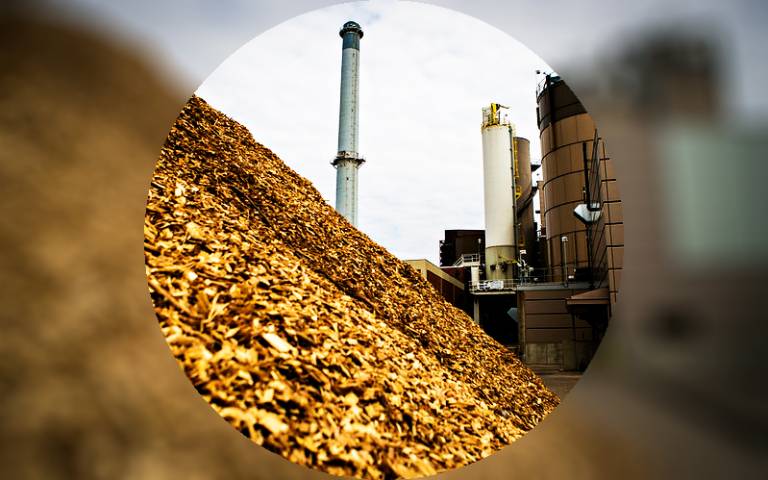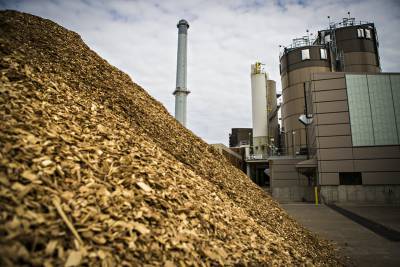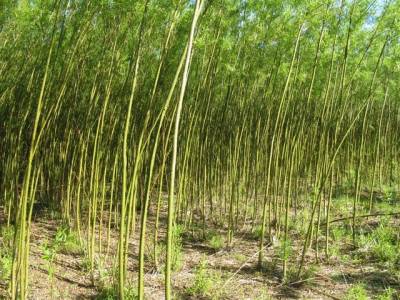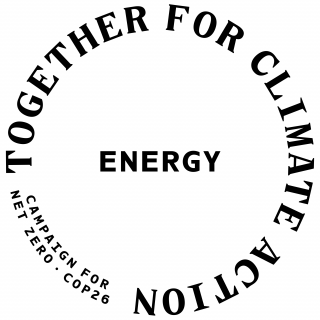Can BECCS help us get to net zero?
20 July 2021

At a glance
- Bioenergy with Carbon Capture and Storage (BECCS) systems have been described as carbon negative options, suggesting that they can remove carbon dioxide (CO2) from the atmosphere for long-term storage.
- BECCS is expected to be a major contributor to removing large volumes of CO2 in the UK and therefore to reaching Net Zero by 2050.
- Concerns regarding the deployment of BECCS on a large scale are growing, particularly related to potentially delaying mitigation efforts and ensuring a sustainable biomass feedstock.
- Fast-paced reduction of GHG emissions is needed to reduce the scale of CO2 removal needed to reach Net Zero by 2050.
- If BECCS options are deployed, they should be implemented incrementally and cautiously, conditional on stringent monitoring, verification and reporting (MRV) of emissions along their supply chains, to ensure that the CO2 removal is genuine.
Background
BECCS as a CO2 removal option
Biomass with carbon capture and storage, abbreviated as BECCS, is an umbrella term for systems that apply carbon capture technology to biomass-based energy production in order to capture carbon dioxide (CO2) and store it securely underground. The concept relies on the ability of plants and trees to remove carbon from the atmosphere, and also on human-made carbon capture and storage equipment (CCS). As they grow, plants absorb CO2 and use it as building blocks for their leaves, roots, stems, bark, etc. all collectively referred to as “biomass”. Plants will also transfer some of this carbon into the ground, improving soil health. If vegetation is left standing, the carbon stored both in soil and biomass will stay locked away, providing a net removal from the atmosphere. This is called natural - or land-based - removal. If instead the vegetation is harvested, it can be converted into energy or materials, and serve to replace fossil-based alternatives. When biomass is used for energy, the carbon it contains is released to the atmosphere as CO2. If these emissions are captured and stored, in underground reservoirs for example, then the overall process can remove CO2 from the atmosphere.
Why do we need BECCS?
The UK has a long history of advocating for climate action and was recently one of the first countries to pass into law the ambitious target of reducing greenhouse gas (GHG) emissions to net zero by 2050. While the path to making this happen is unclear, we do know that it will entail each and every sector of the economy drastically reducing its emissions. Some sectors have made good progress already, with the UK power sector using renewables to cut its emissions by 65% since 2009. Other sectors, like transport, have not been as successful. The challenges these sectors face to fully decarbonise and further delays in reducing emissions will affect our ability to decarbonise fast enough and will leave the system with remaining, “residual”, emissions in 2050.
Delays in delivering decarbonisation, when considered alongside expected levels of “residual” emissions (emissions from processes where removing them is difficult), mean that the question is now less “whether” we will need CO2 removal systems, but rather “how much” of them we will need and which ones we should be using. It has been reported that by 2050 the UK will likely need to remove between 43 to 97 million tonnes of CO2 each year.
BECCS is one of the options that can provide CO2 removal. If done well, it has the potential to transfer carbon from the atmosphere into long-term storage while also producing useful outputs like power, heat, liquid transport fuels, or hydrogen.
What is the issue with BECCS?
In theory, BECCS systems should deliver low-carbon energy along with large-scale CO2 removal. In reality, important aspects of BECCS make this delivery highly uncertain.
BECCS systems are neither simple nor easy to monitor. Rather, they involve very complex supply chains, run by many different players both in the UK and abroad. These stretch from growing and harvesting the crops, to processing the biomass and transporting it to the bioenergy plant, all the way to capturing the CO2 and pumping it into underground caverns. Each step involves some GHG emissions to the atmosphere (see figure below). Interests and priorities diverge at each of these stages making regulation and monitoring of these emissions difficult.

Schematic view of the carbon balance along a full BECCS supply chain. Green arrows show the capture of CO2 by biomass and sequestration in geological storage, red arrows show emissions of GHGs (CO2, methane, and other GHGs) from each stage.

Each stage of a BECCS supply chain can release CO2 and other GHG emissions to the atmosphere. This can be the carbon that was first absorbed during plant growth, but it can also come from other sources, adding to the pool of GHG emissions we are trying to reduce. Cultivating certain types of land can release more carbon from the soil than the plants store. Harvesting too fast or too often can reduce the carbon stored in the area biomass is sourced from. Currently, fossil fuels are used to power the processing, transport and conversion steps. The scale of these emissions varies significantly on a case-by-case basis. Overall, the risk is that they will outweigh the carbon sequestration benefit that BECCS set out to provide.
Supply chain impacts go beyond carbon, with wider impacts on ecosystems, for example polluting or overconsuming water, or risking the replacement of richer primary forests with less biodiverse plantations. Further, the rights of local communities can also be impacted as they use land for leisure activities, or subsistence farming and have strong cultural ties. These impacts are not currently well accounted for by the actors involved or the regulatory systems in place.
Scaling up these supply chains to support a fast-growing demand intensifies these issues with the risk that their impacts will grow disproportionately as the magnitude of the chains increase.
Difficulties with complex and disconnected supply chains are already affecting bioenergy production, creating controversy around whether bioenergy is a low-carbon option and should be subsidised as such. One example of this is the debate around the Drax power station in Yorkshire (see Box).
Finally, there is a real risk that over reliance on BECCS and other CO2 removal options could cause more immediate decarbonisation efforts to slow down. This could happen for instance if funding for CO2 removal displaces investment in immediate mitigation options. The risk here is that allowing GHG emissions to increase in the short term while relying on future technologies to remove them may mean that emissions targets are missed if these technologies do not deliver.
 Wood chippings at a power plant. Image source: flickr
Wood chippings at a power plant. Image source: flickr

Drax power station has received significant public subsidies to convert 4 of its 6 generating units from coal to biomass and has been the subject of strong pressures from NGOs and the wider public, questioning the sustainability of the change1. As it controls the full supply chain, and has been transparent about it, Drax has been able to claim that its conversion has reduced CO2 emissions, but questions remain, especially about whether the “Drax model” should be replicated in the UK or abroad. Drax is now planning to add carbon capture and storage to its biomass plant to produce ‘negative emissions’.
Repeating this model elsewhere is not straightforward. Drax currently uses more than half the global trade of wood pellets2. Building new plants will mean increasing the supply of such pellets, with no clear answers as to how this can be done sustainably, without displacing food production or degrading the forests being harvested, creating more emissions than BECCS is able to remove at the end of its supply chain.
How can we solve it?
The complexity of BECCS supply chains and the risks that they imply increase with size and number of chains. Addressing these then suggests reducing the pressure to scale and multiply these systems faster than we can control.
On the one hand, this means reducing the actual need for CO2 removal by far faster reduction of GHG emissions than is currently being achieved: the lower emissions go early on, the less carbon needs removing, and the less BECCS deployment is under pressure. This implies moving at a faster pace than is currently seen to reduce our use of energy and materials by reducing waste, shifting our lifestyles, and using low carbon materials and energy. Many of these options are further described in other articles in this campaign. They will need to take place across all activities, whether at the individual level, or at a national scale involving complete industries. As we explain in this campaign, finding and applying these low carbon solutions, including in sectors that are harder to decarbonise is a global effort that will imply widespread engagement from citizens, government and industries.
On the other hand, this means defining what “sustainable” BECCS looks like so that this can be applied when designing, deploying and governing BECCS supply chains. In essence, this definition involves setting clear criteria which BECCS systems need to comply with before they can be called ‘sustainable’. These need to consider both carbon and other GHG emissions but also wider environmental issues, such as water quantity and quality, biodiversity, and social impacts.
One element of this is to ensure that each process along the supply chain should be as close to net-zero GHG emissions as possible. This may be helped by keeping processes local with short supply chains: for example, choosing UK-produced biomass transported via train for local use may significantly reduce impacts compared to long-distance shipping, which currently uses heavy fuel oil. Substituting such fuels with clean alternatives wherever they are in the supply chain will also improve the carbon balance of BECCS.
 Willow plantation - biomass production. Image credit: M J Richardson from geograph.org.uk
Willow plantation - biomass production. Image credit: M J Richardson from geograph.org.uk

What makes this difficult
Establishing sustainability criteria would provide a rule book as to what type of biomass, and which production practices, are globally acceptable. However, this is not a trivial task. The challenges and risks associated with biomass production are very location and context specific, so setting criteria which apply to all circumstances is both difficult and controversial. This is made harder by the uncertainty that still surrounds our knowledge of how each step in the chain works, and of how to measure the impacts. Getting the rules wrong, or setting them without proper consultation with those affected by them, can lead to negative environmental and social impacts that may negate the benefits of BECCS.
Once rules are established, it is vital that good data about the different supply chains, perhaps in different countries, is gathered and used in a systematic way. This suggests the need to establish an independent institutional system that monitors, reports, and verifies (MRV) the data, with international agreement, to keep track of the emissions and energy use that relate to BECCS. This does not currently exist in the UK or anywhere else. Establishing such an agreement, and the shared responsibility that it implies, will not be easy.
Finally, BECCS supply chains are underpinned by the land that is used to produce the biomass. Understanding “sustainable biomass supply” therefore requires an understanding of “sustainable uses of land”, which adds additional complexity. Land has deep cultural, social, and environmental connotations, many of which do not tend to feature highly in decision making. All of these affect the full-picture supply chain balance of scaling up BECCS.
How can we move forward?
Having a net-zero target implies that any emissions that are added to the atmosphere will need to be compensated by some form of CO2 removal. Reducing emissions will relieve pressure on having to scale up BECCS and other CO2 removal options and reduce the risk this happens unsustainably. Government of course has a crucial role in emission reduction, but so do businesses and individuals, through how they use energy, how they heat their buildings and what transport they use.
On a governmental level, BECCS must be assessed transparently and compared to other CO2 emissions reduction and removal options. This requires the establishment of an independent body for MRV of carbon removal. By focusing on the full supply chains, both for domestic and imported biomass, this could then ensure that incentive payments reward actual CO 2 removal. UK action in this area should set the tone for an international discussion on establishing a global organisation with a mandate to convene and facilitate these discussions openly and fairly.
There also needs to be a recognition that BECCS supply chains have implications well beyond carbon, interacting with land, ecosystems and cultural frameworks, all of which have multiple values that need to be recognised and taken into account.
On a practical level, support should be given to multiple small-scale BECCS trials that consider the full supply chain. As MRV data is reviewed and impacts become better known, these can be expanded incrementally and cautiously. Looking for opportunities for biomass production that have additional benefits for biodiversity, soil quality, flood protection, local economies and more, solutions with the best all-round results can be prioritised.
Some of these steps may seem further removed from people’s direct realm of action, however citizens can get more actively involved in the climate debate at a local level and interact with NGOs in this field. Working to understand the emissions implications of our choices, and acting to reduce them, are positive steps. Engaging with the media on these topics, requesting information about certifications and standards that identify “sustainable” products – including biomass – make a difference. Taken together, these choices will build a national sense of what is considered important.
Key messages
- Fast and immediate reduction of GHG emissions at all levels - personal, household, community, national, and global - is paramount. Less GHG emitted now means less removal needed as we come closer to 2050.
- Increased awareness about CO2 removal options is needed, about how they work, the consequences of deploying them and how they compare to other options. Trialling several options would allow those with the best all-round results to be prioritised.
- Any implementation of BECCS needs transparent accounting rules, monitoring and reporting, to guarantee genuine CO2 removal while also ensuring they deliver other benefits such as improved air quality, protection against floods and increased biodiversity.
Key references for further information
- ECF report – particularly in relation to the sustainability of biomass.
- Climate Change Committee - Sixth Carbon Budget
 Close
Close


